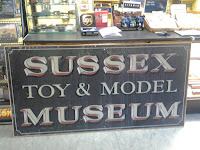 |
| "Artistic" QR code for the Museum's Wiki landing page |
If you haven't yet seen them,
QR codes are the 21st century version of barcodes. They're like a graphical successor to
Morse Code - they store text, and when you wave your smartphone camera at a QR code with the
Google Goggles app running, it sees the code, works out how the image is aligned, and then offers to show you the hidden text, launch a file, or take you to a website page.
If you're in the Museum and you look at the bottom left corner of a cabinet, you should see a small QR code sticker whose embedded text leads to the online Wiki web page for that cabinet, and to a listing of any of the cabinet's items that have been given their own Wiki entries.
One of the great things about the Museum is that its collections are organised organically and sympathetically, with surrounding exhibits and backdrops providing a sense of context. It's a series of little worlds, not just a set of labelled items sitting in isolated cells. The Museum is a forest of toys and models ... or perhaps a jungle ... and exploring it is like going on safari to do some wildlife photography. It's a visual onslaught of period design and craftmanship.
 |
"Artistic" QR code for the Museum's "Train Running Day" event.
Scan me! |
The exhibits are so densely packed, and many of them are so small, that if we labelled everything in the Museum using a conventional approach it wouldn't just disrupt the visual spell, it would require so much additional paper to be stuffed into the cabinets that you probably wouldn't be able to even
/see/ the exhibits, and this makes "virtual labelling" an attractive option, once a sufficient proportion of visitors have camera-equipped smartphones.
Eventually we should end up with the best of both worlds, old and new, with the exhibits free to be arranged in whatever manner is most appropriate to the period, and with invisible 21st-Century technology providing background information and links to online resources and multimedia on the visitors' own mobile devices, without intruding on or spoiling the display space.
We're not quite there yet. Since we're built into a Victorian basement (under a steel bridge!), mobile phone signals don't yet penetrate very far into the Museum, and the Museum's wifi hasn't /yet/ been extended to reach more than about a third of the total museum floorspace, so we still have some work to do. It may also be that in a few years' time, QR codes will have been replaced with a newer technology such as
NFC, and it might be that in 2018 you'll be placing your NFC-equipped smartphone against a cabinet to get a readout of its contents. But the organisational groundwork that we're doing now with QR codes will hopefully transfer across easily to whichever future technologies end up being used.










.jpg)











